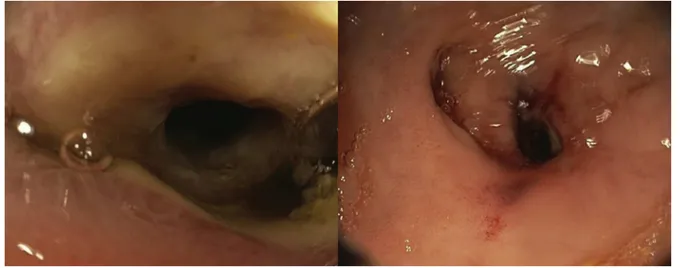jcoloproctol(rioj).2015;35(4):223–226
w w w . j c o l . o r g . b r
Journal
of
Coloproctology
Case
Report
A
case
of
rectal
stricture
associated
with
the
use
of
a
fecal
management
system
Kshitij
Chatterjee
a,∗,
Jagpal
Singh
Klair
a,
Abhishek
Agarwal
a,b,
Farshad
Aduli
a,b aDepartmentofInternalMedicine,UniversityofArkansasforMedicalSciences,LittleRock,UnitedStatesbDivisionofGastroenterologyandHepatology,DepartmentofMedicine,UniversityofArkansasforMedicalSciences,LittleRock,United
States
a
r
t
i
c
l
e
i
n
f
o
Articlehistory:
Received5March2015
Accepted8June2015
Availableonline21September2015
Keywords:
Bowelmanagementsystem
Rectalstricture
Bowelobstruction
a
b
s
t
r
a
c
t
Fecalmanagementsystemsarewidelyusedtopreventcomplicationsoffecalincontinence
suchasskinbreakdownandpressureulcers.Howevertheyareoccasionallyassociatedwith
complicationssuchasbleedingandpressurenecrosisofrectalmucosa.Wepresentapatient
withClostridiumdifficilecolitiswithaprolongedhospitalstayrequiringtheuseofFlexi-Seal
FecalManagementSystemwhodevelopedabdominalpainanddistentionwithobstipation.
Computedtomographyofabdomenshoweddilatationofsmallandlargebowelloopswitha
transitionpointatrectosigmoidjunction.Flexiblesigmoidoscopyrevealedthepresenceofa
severestrictureattherectosigmoidjunctionthatwasnotamenabletoendoscopicdilation.
Surgicalresectionwithanend-colostomywasperformedtorelievetheobstruction.Tothe
bestofourknowledge,thisisthefirstreportedcaseofahigh-gradestrictureduetouseof
bowelmanagementsystemthatneededbowelresectionsurgery.
©2015SociedadeBrasileiradeColoproctologia.PublishedbyElsevierEditoraLtda.All
rightsreserved.
Caso
de
constric¸ão
retal
associada
ao
uso
de
um
Sistema
de
manejo
fecal
Palavras-chave:
Sistemademanejointestinal
Constric¸ãoretal
Obstruc¸ãointestinal
r
e
s
u
m
o
Sistemas de manejo fecal são amplamente utilizados com o objetivo de evitar as
complicac¸ões da incontinênciafecal, além deavarias à pelee úlceras de decúbito.No
entanto,ocasionalmenteessessistemasestãoassociadosacomplicac¸ões, como
sangra-mentoenecroseporpressãodamucosaretal.Apresentamosumpacientecomcolitepor
Clostridiumdifficilecomprolongadapermanêncianohospitalequenecessitoudousodo
Flexi-SealFecalManagementSystem;essepacienteveioasofrerdoresedistensãoabdominal,
juntamentecomobstipac¸ão.Atomografiacomputadorizadadoabdomereveloudilatac¸ão
dealc¸asdeintestinedelgadoegrosso,comumpontodetransic¸ãonajunc¸ãoretossigmóidea.
∗ Correspondingauthor.
E-mail:kchatterjee@uams.edu(K.Chatterjee).
http://dx.doi.org/10.1016/j.jcol.2015.06.005
224
jcoloproctol(rioj).2015;35(4):223–226Asigmoidoscopiaflexívelreveloupresenc¸adegrandeconstric¸ãonajunc¸ãoretossigmóidea,
quenãopermitiadilatac¸ãoendoscópica.Realizamosressecc¸ãocirúrgicacomcolostomia
terminal,comoobjetivodealiviaraobstruc¸ão.Atéondevainossoconhecimento,esteéo
primeirocasorelatadodeconstric¸ãodealtograucausadapelousodeumsistemademanejo
intestinalnecessitandodecirurgiaderessecc¸ãointestinal.
©2015SociedadeBrasileiradeColoproctologia.PublicadoporElsevierEditoraLtda.
Todososdireitosreservados.
Introduction
Diarrhealeadingtofecalincontinenceisachallenging
prob-lemintheacuteand criticalcaresetting.1 Thepresenceof
fecalincontinencecomplicatestheclinicalcourseofpatients
byfacilitatingthedevelopmentofskinbreakdown,pressure
ulcers, and also promotes the transmission of nosocomial
infectionslikeClostridiumdifficilecolitis.2,3 Overtherecent
years,fecalmanagementsystemshaveevolvedasanefficient
waytodivertstoolandreducethesecomplications.However,
the devices are associatedwith anincreased riskofrectal
trauma.Wepresentacaseofrectalstrictureassociatedwith
theuseofflexi-sealfecalmanagementsystem(FMS)resulting
inintestinalobstruction.Thepurposeofthiscasereportisto
familiarizetheclinicianaboutthebenefitsandpossible
com-plicationsofusinganintra-rectalFMSinhospitalizedpatients
withfecalincontinence.
Case
presentation
A 47-year-old Caucasian male presented with progressive
abdominalpainanddistentionover4weeksandobstipation
for2days. Healsohadnauseaand vomitingwith
obstipa-tionfor2days.Hehada30-lbweightlossoverthepreceding
2months.He had nohistory ofabdominalsurgeries other
thanagastrostomytubeplacement3monthsago.His
med-ical history was significant for hypertension and coronary
artery disease. Also, 3 months ago, he had a recent
pro-longedhospitalizationfollowingorthopedictraumaduetoa
tornado.Duringthistime,hedevelopedclostridiumdifficile
diarrheaandwastreatedwithcoursesofmetronidazole
fol-lowedbyvancomycin.Thehighvolumediarrheanecessitated
the placementof theFlexi-Seal FecalManagement System
thatremainedinplaceforaweek.
Upon presentation, his vital signs were stable, but he
appeared very malnourished. His abdomen appeared
dis-tendedandtympanic.PlainX-raysshoweddilatedsmallbowel
loopswithmultipleairfluidlevelsandpaucityofairinthe
colon(Fig.1).Acomputedtomography(CT)oftheabdomen
showednarrowingattherectosigmoidregionwithdilatation
ofproximalsmallandlargebowelloops.Patientwasstarted
onconservativemanagementwithnilpermouth,intravenous
fluids,andnasogastrictubedecompression.
Aflexiblesigmoidoscopyshowedaseverestricturefroma
concentriculcerat15cmfromtheanalverge(Fig.2).Eventhe
smallestdiameter(4.8mm)endoscopecouldnotbetraversed
pastthestricture.Thebiopsyrevealedinflammatorystricture
withulceration. With failure ofconservative management,
patientunderwentalaparoscopicconvertedtoopen
rectosig-moidresectionwithend-colostomy.Duringsurgery,thecolon
wasnotedtobemassivelydilatedandtheupperrectumwas
notedtobescarreddowntoafibroticbandwithnoobvious
lumen. Pathology of the strictured area showed mucosal
ulcerationwithunderlyingmuralandserosalfibrosis
consis-tentwithstricture.Therewasnoevidenceofviralinclusions
ormalignancy.
Discussion
Fecal incontinence secondary to diarrhea is a commonly
encounteredentityinpatientsinthe inpatientsettingwith
the rates being significantly higher in the patients in the
intensive careunits.1,4 Fecalincontinence hasbeen clearly
associated with an increased risk for the development of
pressureulcers,woundinfectionandtransmissionof
hospi-talacquiredinfections.2,3,5Traditionallyabsorbentpadsand
rectalpoucheshavebeenusedforreducingsoilingand
con-taminationbuttheyhavesignificantlimitationsoftheirown.
Absorbentpadsallowperianalsoilingandchangingpads
fre-quentlyinapatientwithdiarrheaisnottimeefficientforthe
nursingstaff.Rectalpouchesoftenhavesignificantleakage
aroundthemandfailtopreventinfectiontransmission.
Flexi-sealfecalmanagementsystem(FMS)wasintroduced
in2006withtheaimtoeffectivelymanagefecalincontinence.
Thedeviceconsistsofa1mlongsiliconecannulawitha
flex-ibleannularballoonattherectalendtoholditinplace.The
balloonistypicallyinflatedwitharound45mLofwaterandthe
signalindicatorgivesanestimateofpressureintheballoon.
Theflexi-sealFMSwasevaluatedinaprospective,singlearm
studyof42patientsandwasfoundtobeeffectiveintermsof
maintainedskin-integrityduringthecourseofthetreatment
andwasalsoreportedtobetime-efficient.6Onepatientamong
these42had arectalulcerationandalowerGIbleed
prob-ablyassociatedwiththeuseofthedevice.Fewcasereports
havebeenpublisheddescribingrectaltraumaintheformof
mucosal tear,laceration,and ulcerationwithbleedingwith
theuseofflexi-sealFMS.7,8 Thesefindingswerereportedas
likelyrelatedtosuddenmovementofthedeviceliketraumatic
removalorrelatedtoinsertion.Patientsreceivingtherapeutic
dosesofanticoagulationand antiplateletdrugsare
particu-larlyatriskforcomplications.
To the best of our knowledge, this paper describes the
first reportedcaseofastrictureassociatedwiththe useof
theflexi-sealfecalmanagementsystem.Astheulcerseenon
sigmoidoscopywasconcentricinnatureleadingtostricture
withoutcausingpreviousbleeding,itseemsmorelikelythat
jcoloproctol(rioj).2015;35(4):223–226
225
Fig.1–PlainX-rayabdomenshowingdilatedloopsofsmallintestine,paucityofgasindistendedcolonloopsandmultiple air-fluidlevels.
Fig.2– FlexibleSigmoidoscopyshowingaseverelynarrowedstricturenearupperrectum.
Eventhoughthe annularballoonisalow-pressuresystem,
thereisaconcernforpressurenecrosis,asitremainsinflated
throughouttheperiodthedeviceisinsitu.Thedurationof
usageofthedevicewasrecommendedas≤29daysinthestudy
evaluatingitssafety;however,themeandurationwas5.6(1to
14)days.6Sparksetal.reportedacaseofulcerationinanal
canalresultinginbrightredblood perrectumonday22of
insertionofthefecalmanagementsystem.8Theyreportedthe
ulcerationtobeconsistentwiththeplastictubingoftheFMS.
Furtherevaluationisnecessitatedonthesafemaximumtime
thedevicecanbeused.Intermittentlydeflatingtheballoon
mightalsobestudiedtoassesstheimpactondeviceefficacy
andcomplications.Thecontraindicationsforusingthedevice
includepreviousanorectalsurgeriesoranorectalconditions
suchasstrictureorstenosis,severerectalhemorrhoids,rectal
tumors,orsevereproctitis.9Studyingthesafetyofthedevice
inavarietyofclinicalscenarios,usageconcomitantwith
anti-coagulants,anditsuseinfrailpatientsmorepronetotrauma
areotherareasthatneedfurtherattention.
Conflicts
of
interest
Theauthorsdeclarenoconflictsofinterest.
r
e
f
e
r
e
n
c
e
s
226
jcoloproctol(rioj).2015;35(4):223–2262.GrayM,RatliffC,DonovanA.Protectingperinealskinintegrity. Incontinentpatientspresentuniquechallengestosuccessful skincaremanagement.NursManage.2002;33:61–3.
3.DonskeyCJ.Theroleoftheintestinaltractasareservoirand sourcefortransmissionofnosocomialpathogens.ClinInfect Dis.2004;39:219–26.
4.NelsonRL.Epidemiologyoffecalincontinence. Gastroenterology.2004;126:S3–7.
5.TheakerC,MannanM,IvesN,SoniN.Riskfactorsforpressure soresinthecriticallyill.Anaesthesia.2000;55:221–4.
6.PadmanabhanA,SternM,WishinJ,ManginoM,RicheyK, DeSaneM,Flexi-SealClinicalTrialInvestigatorsG.Clinical
evaluationofaflexiblefecalincontinencemanagement system.AmJCritCare.2007;16:384–93.
7.PageBP,BoyceSA,DeansC,Camilleri-BrennanJ.Significant rectalbleedingasacomplicationofafecalcollectingdevice: reportofacase.DisColonRectum.2008;51:1427–9.
8.SparksD,ChaseD,HeatonB,CoughlinL,MethaJ.Rectal traumaandassociatedhemorrhagewiththeuseofthe convatecflexi-sealfecalmanagementsystem:reportof3 cases.DisColonRectum.2010;53:346–9.
9.Flexi-sealFecalManagementSystem[package-insert].
F-SFMSp,PrincetonNC,aDivisionofE.R.Squibb&Sons,LLC;
